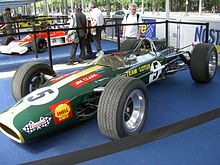McLaren Racing Limited is a British motor racing team based at the McLaren Technology Centre in Woking, Surrey, England. McLaren is best known as a Formula One constructor, the second oldest active team and the second most successful Formula One team after Ferrari, having won 183 races, 12 Drivers' Championships and 8 Constructors' Championships. McLaren also has a history of competing in American open wheel racing, as both an entrant and a chassis constructor, and has won the Canadian-American Challenge Cup (Can-Am) sports car racing championship. The team is a subsidiary of the McLaren Group, which owns a majority of the team.

British American Racing (BAR) was a Formula One constructor that competed in the sport from 1999 to 2005. BAR began by acquiring Tyrrell, and used Supertec engines for their first year. Subsequently, they formed a partnership with Honda which lasted for the next six years.

Marlboro is an American brand of cigarettes owned and manufactured by Philip Morris USA within the United States and by Philip Morris International outside the US except Canada where the brand is owned and manufactured by Imperial Tobacco Canada. Marlboro's largest cigarette manufacturing plant is located in Richmond, Virginia.
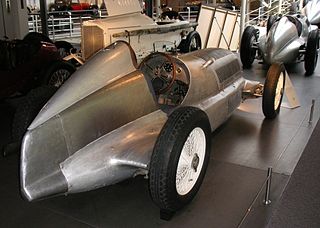
Silver Arrows is a nickname typically given to silver racing cars with a significant connection to a German car manufacturer. Although the term was coined in 1932, it came into popular usage regarding Germany's dominant Mercedes-Benz and Auto Union Grand Prix motor racing cars between 1934 and 1939. The name was later applied to the Mercedes-Benz Formula One and sports cars in 1954 and 1955, then to the Sauber Group C prototype racing sports cars that raced at Le Mans in the late 1980s as well as the McLaren-Mercedes Formula One cars of the late 1990s and 2000s, and is currently applied to the Mercedes-AMG Petronas F1 cars from 2010 to present.
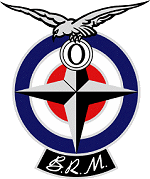
British Racing Motors (BRM) was a British Formula One motor racing team. Founded in 1945 and based in the market town of Bourne in Lincolnshire, it participated from 1951 to 1977, competing in 197 grands prix and winning seventeen. BRM won the constructors' title in 1962 when its driver Graham Hill became world champion. In 1963, 1964, 1965 and 1971, BRM came second in the constructors' competition.
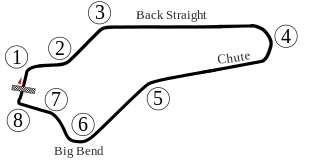
The 1961 United States Grand Prix was a Formula One motor race held on October 8, 1961, at the Watkins Glen Grand Prix Race Course in Watkins Glen, New York. It was the eighth and final race in both the 1961 World Championship of Drivers and the 1961 International Cup for Formula One Manufacturers.

The 1968 Formula One season was the 22nd season of the FIA's Formula One motor racing. It featured the 19th FIA World Championship, which commenced on 1 January, and ended on 3 November after twelve races, and numerous non-championship races. Graham Hill won the second of his World Championship titles, with Lotus.
British racing green, or BRG, is a colour similar to Brunswick green, hunter green, forest green or moss green. It takes its name from the green international motor racing colour of the United Kingdom. This originated with the 1903 Gordon Bennett Cup, held in Ireland, as motor-racing on public roads was illegal in Great Britain. As a mark of respect, the British cars were painted shamrock green.

Team Lotus was the motorsport sister company of English sports car manufacturer Lotus Cars. The team ran cars in many motorsport categories including Formula One, Formula Two, Formula Ford, Formula Junior, IndyCar, and sports car racing. More than ten years after its last race, Team Lotus remained one of the most successful racing teams of all time, winning seven Formula One Constructors' titles, six Drivers' Championships, and the Indianapolis 500 in the United States between 1962 and 1978. Under the direction of founder and chief designer Colin Chapman, Lotus was responsible for many innovative and experimental developments in critical motorsport, in both technical and commercial arenas.

The Lotus 49 was a Formula One racing car designed by Colin Chapman and Maurice Philippe for the 1967 F1 season. It was designed around the Cosworth DFV engine that would power most of the Formula One grid through the 1970s. It was one of the first F1 cars to use a stressed member engine combined with a monocoque to reduce weight, with other teams adopting the concept after its success. It also pioneered the use of aerofoils to generate downforce.
The Japanese automobile manufacturer Honda has participated in Formula One, as an engine manufacturer and team owner, for various periods since 1964. Honda's involvement in Formula One began as a full team and engine entry in the 1964 season, and in 1965 they achieved their first victory at the Mexican Grand Prix. After further success with John Surtees, Honda withdrew at the end of the 1968 season due to difficulties selling road cars in the United States and Honda driver Jo Schlesser's fatal accident.

Rosso corsa is the red international motor racing colour of cars entered by teams from Italy.
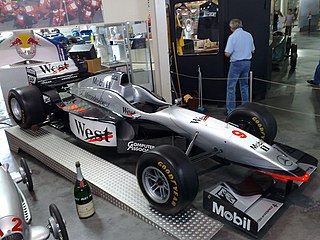
The McLaren MP4/12 was the Formula One car with which the McLaren team competed in the 1997 Formula One World Championship. The chassis was designed by Steve Nichols, Neil Oatley and Henri Durand with Mario Illien designing the bespoke Ilmor engine. It was driven by Mika Häkkinen and David Coulthard.

The Renault R27 is a Formula One racing car designed and produced by Renault for the 2007 Formula One season. The chassis was designed by Bob Bell, James Allison, Tim Densham and Dino Toso with Pat Symonds overseeing the design and production of the car as Executive Director of Engineering and Rob White leading the engine design. The car was driven by Giancarlo Fisichella and Heikki Kovalainen.

The Honda RA107 is a Formula One racing car with which Honda Racing F1 contested the 2007 Formula One season. A modified version of the RA107, renamed the Super Aguri SA08 was used by Super Aguri in the 2008 Formula One season. The RA107 was the first Formula One car designed under former HRC motorcycle designer, Shuhei Nakamoto.
Formula One sponsorship liveries have been used since the 1968 season. Before the arrival of sponsorship liveries in 1968 the nationality of the team determined the colour of a car entered by the team, e.g. cars entered by Italian teams were rosso corsa red, cars entered by French teams were bleu de France blue, and cars entered by British teams were British racing green. Major sponsors such as BP, Shell, and Firestone had pulled out of the sport ahead of this season, prompting the Fédération Internationale de l'Automobile to allow unrestricted sponsorship.

Ecurie Bonnier, Ecurie Suisse, Joakim Bonnier Racing Team and Anglo-Suisse Racing Team were names used by Swedish racing driver Joakim Bonnier to enter his own cars in Formula One, Formula Two and sports car racing between 1957 and his death in 1972. Commonly the vehicles were entered for Bonnier himself, but he also provided cars for a number of other drivers during the period.

The Cooper T53 is a Formula One car built by British motorsport team Cooper for the 1960 Formula One season. Jack Brabham drove it to his second World Championship that year, and with teammate Bruce McLaren gave Cooper its second Constructors' Championship.

Aston Martin is a British car manufacturer that has participated in Formula One in various forms and is currently represented by a team named as Aston Martin Aramco F1 Team. The company first participated in Formula One during the 1959 season, where they debuted the DBR4 chassis using their own engine, but it failed to score any points. They continued to perform poorly through the 1960 season, once again failing to score any points. As a result, Aston Martin decided to leave Formula One after 1960.



